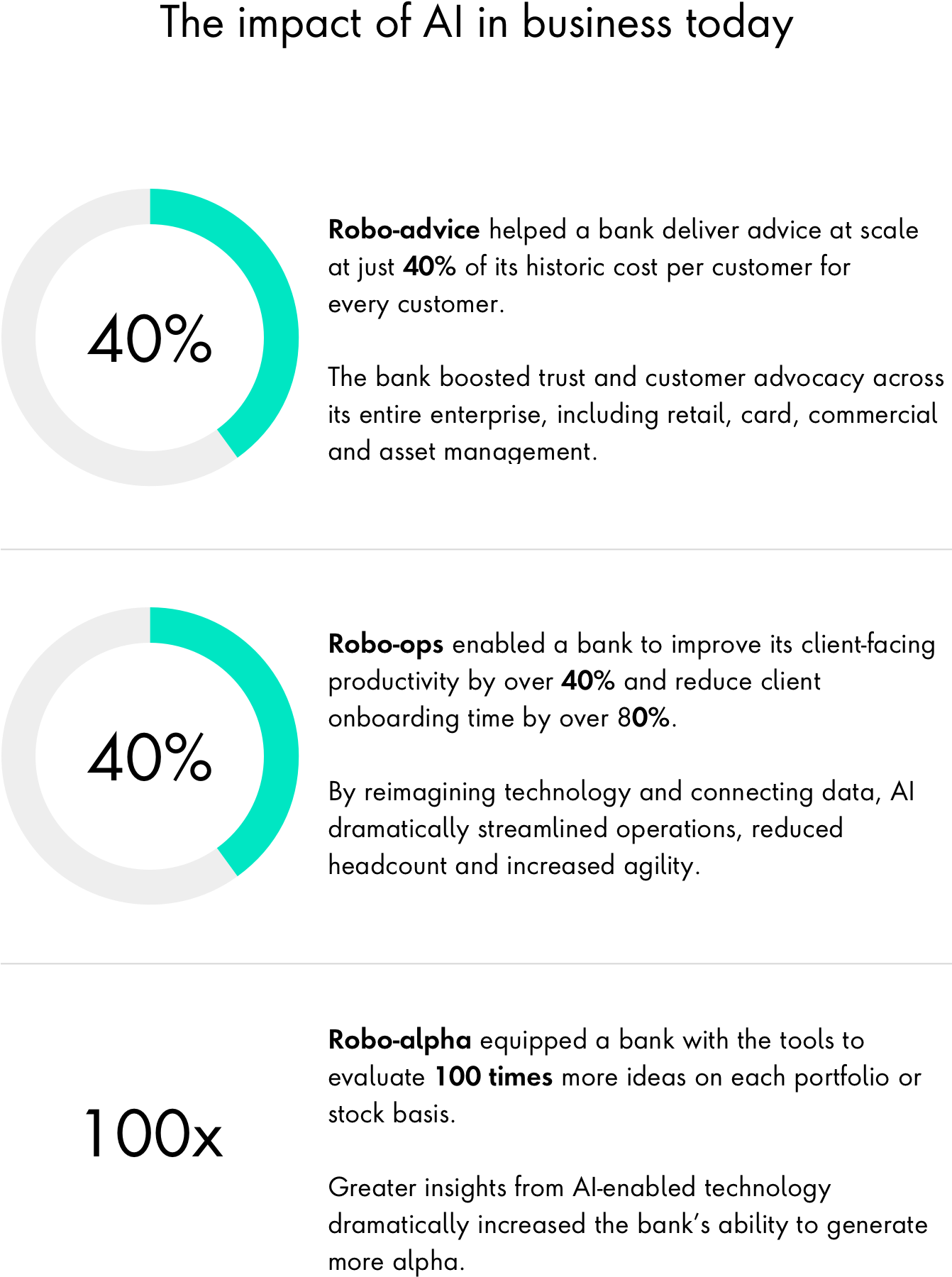In client-centric financial services organizations, AI can fundamentally improve business performance. The recipe for success is to enhance the advice they can provide at scale, reduce costs and then derive greater value from what they have. AI can help them achieve this through three distinct yet interlinked applications: robo-advice, robo-ops and robo-alpha.
Robo-advice
A growing challenge for firms is how to consistently offer high-quality advice at scale. That means providing personalized recommendations to clients that are relevant, suitable, timely and actionable. To do so requires them to truly understand each client’s needs and offer an experience that supports both digital and integrated human interactions.
AI can help by delivering advice directly to the customer or to the relationship manager, who then integrates it into their support. A key aspect of this is automating insight generation. With AI, firms are automatically extracting previously unknown insights from structured and unstructured data, based on predictive patterns and causal connections. This enables them to identify and act on recommended actions for improved competitive advantage. As such, AI is providing valuable resources as well as intelligence throughout the entire customer journey, from initial contact and onboarding through to ongoing service.
Morgan Stanley will be using AI to support its 16,000+ financial advisors by taking over routine tasks as well as augmenting advice.³ The project, “next best action,” will use machine learning to make recommendations and also track phone, email and web interactions to improve suggestions over time.
In the UK, HSBC is using robo-advice to deliver quality advice efficiently to customers with savings of less than £15,000.⁴ The UK's high street banks previously withdrew from providing investment advice to this market following fines for mis-selling and more stringent regulations. Robo-advice offers an opportunity to close the advice gap through a lower-cost, conduct-controlled service.
Robo-ops
Removing inefficiencies is perhaps one of the most valuable applications of AI. Poor data quality, evolving regulations and legacy IT structures all contribute to the complexity and time-consuming nature of many processes. As a result, firms are redesigning the workspace environment for colleagues and customers by automating the simplest tasks to minimize friction and operational risk.
Using AI to eradicate repetitive tasks liberates employees from the more monotonous duties that require little cognitive effort beyond common sense. Intelligent process automation (IPA) is AI-enabled robotic process automation (RPA) and one such technology that reduces costs as well as headcount.
IPA essentially augments the workforce with a team of software robots. Common applications today include companies using chatbots to handle online client interactions and answer frequently asked questions; IT departments monitoring the health of network devices and operations; and finance teams speeding up backoffice work such as data entry and reconciliation.
In financial services, there are many other opportunities, particularly within data management. For example, an investment bank might have several manual processes to ensure any changes to instrument data arriving upstream are reflected in the downstream systems. IPA can transform this function with robots retrieving data exceptions from the source system and entering the information downstream. This allows staff to reallocate their time to more valuable tasks such as serving customers.
While robo-ops can lead to some significant cost savings, other major benefits include quicker completion of processes such as customer onboarding, improved accuracy throughout the customer experience and the ability to scale resources to meet changing demand.
IPA has been helping Deutsche Bank improve productivity and augment its workforce, according to reports. Applications in trade finance, cash operations, loan operations, tax and others have achieved between 30 and 70 percent automation, improving quality and decreasing risk. IPA has also reduced the time is takes to train employees.⁵ By encoding knowledge through robotics, information becomes available to augment employee’s skills and guide them through their everyday responsibilities.
Meanwhile, Goldman Sachs has increased the use of complex algorithms with machine-learning capabilities to streamline its trading operations. It now has two traders on its US cash equities trading desk, down from 600 in the year 2000. The bank applied automated programs, supported by computer engineers, in areas where it was easy to determine price and is extending them to the likes of currencies and credit.⁶
Robo-alpha
Having enhanced their advice and reduced inefficiencies, firms can focus on monetizing the value and knowledge held inside the enterprise.
AI can amplify human intelligence and judgment within the organization by providing contextual knowledge and support. This helps both customers and employees perform tasksin increasingly simple and effective ways. With more time, employees can mine data for greater insights and provide more value to their customers. Some examples of amplified human intelligence include expert assistants and intelligent searching.
One reported use case is J.P. Morgan’s AI program LOXM, which will execute trades across its global equities business.⁷ Unlike algorithmic trading, LOXM will learn from historic trades to set its own parameters rather than rely purely on trader input. It will then execute orders at the fastest speed and best possible price. Its growing intelligence will enable it to tackle problems such as how to best offload big equity stakes without moving market prices. In the future, LOXM could get to know each individual customer, taking into account his or her behavior when deciding how best to trade.











